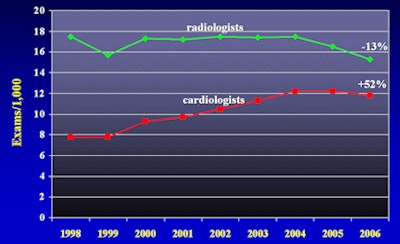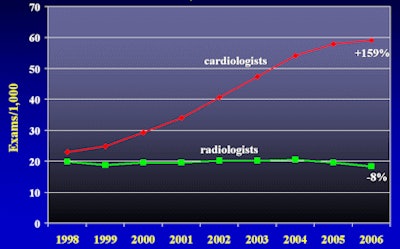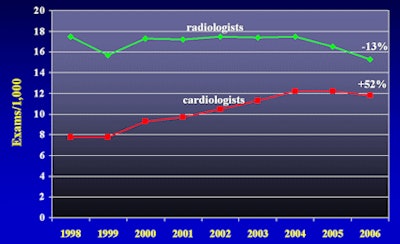
Clinical research has shown that nuclear myocardial perfusion imaging (MPI) is a significant indicator of cardiac death and, as such, can be a powerful tool in a physician's arsenal in the battle against heart disease.
But this procedure is costly and, in the current healthcare environment, in which delivering the best care for the most effective cost is a key goal, researchers are investigating how MPI is used -- and by whom -- to evaluate whether overuse of the technology contributes to inflated healthcare costs.
Dr. David Levin and colleagues at Thomas Jefferson University Hospital in Philadelphia compared nuclear MPI use trends among radiologists and cardiologists, tracking them from 1998 to 2006 using Medicare Part B claims databases. Levin presented the study's findings at the 2008 RSNA meeting in Chicago.
"Given that MPI is a mature technology and there is no evidence for increase in incidence of coronary artery disease, the sharp rise in use of MPI by cardiologists is likely due to self-referral," Levin said.
MPI is a good technology to use for this kind of comparative study, Levin said, because there is ongoing controversy between radiologists and cardiologists over who should perform the tests, and payors are concerned about self-referral practices.
"If you want to study self-referral patterns, MPI is a good model to use, because it's a high-tech, high-cost procedure and it's done in large numbers by both radiologists and cardiologists," Levin said. "It's also probably the largest-volume and highest-cost procedure performed by nonradiologists."
The study used the four primary MPI codes, as well as Medicare's physician specialty codes to identify radiologists, cardiologists, and other physicians. The team calculated use rates per 1,000 Medicare patients for MPI and for related procedures such as stress echocardiography and invasive diagnostic coronary angiography.
Levin's team found that radiologists actually decreased their use of MPI between 1998 and 2006 by 8%, while cardiologists increased their use of the technology by 159%, the bulk of which occurred in private offices.
|
 |
| Nuclear MPI utilization rates, radiologists and cardiologists, Medicare 1998-2006, all sites of service. Image courtesy of Dr. David Levin, Thomas Jefferson University Hospital. |
In 2006, the private office rate of MPI use among cardiologists was 47.3 per 1,000 Medicare beneficiaries, compared with 2.5 among radiologists. In the hospital setting, the rate of MPI use for radiologists was 15.3 per 1,000 Medicare beneficiaries, versus 11.8 among cardiologists, demonstrating that although radiologists still perform more MPI exams than cardiologists in hospitals, the gap is closing.
 |
| Nuclear MPI utilization rates, radiologists and cardiologists, Medicare 1998-2006, hospital setting only. Image courtesy of Dr. David Levin, Thomas Jefferson University Hospital. |
Levin and his team also found that cardiologists' use of stress echocardiography and diagnostic coronary angiography both increased 20% during the time period.
Were the results surprising? Yes and no, according to Levin. He said that he's been tracking self-referral for years, and increased use rates by nonradiologists are not new.
"I was surprised at the magnitude of the increase," he said. "When you look at the cardiologist use rate going up by 159%, compared to the radiologist use trend being flat, or even slightly down, it hits you in the fact that this is what happens in the system when we allow self-referral."
Fixing a broken healthcare system, and particularly staunching the practice of self-referral, isn't an easy job, Levin said.
"It takes a lot of political will to tackle this," he said. "Cardiologists are to some degree justified in using this technology, and they do get training in it as part of their fellowships. But other self-referral practices -- like orthopods putting MRI in their offices, or urologists installing CT -- that's just pure money-making effort. Self-referral has to be wrung out of the system if we're going to control imaging costs."
By Kate Madden Yee
AuntMinnie.com staff writer
December 15, 2008
Related Reading
Health reform plan includes payment changes, November 13, 2008
CMS avoids tackling self-referral in MPFS and HOPPS rules, November 4, 2008
ACR: Maryland self-referral case in appeal, October 23, 2008
Stalking self-referral: OIG reports on MRI services paid under MPFS, October 15, 2008
Self-referral 'sunshine' bill introduced in House, August 5, 2008
Copyright © 2008 AuntMinnie.com





















